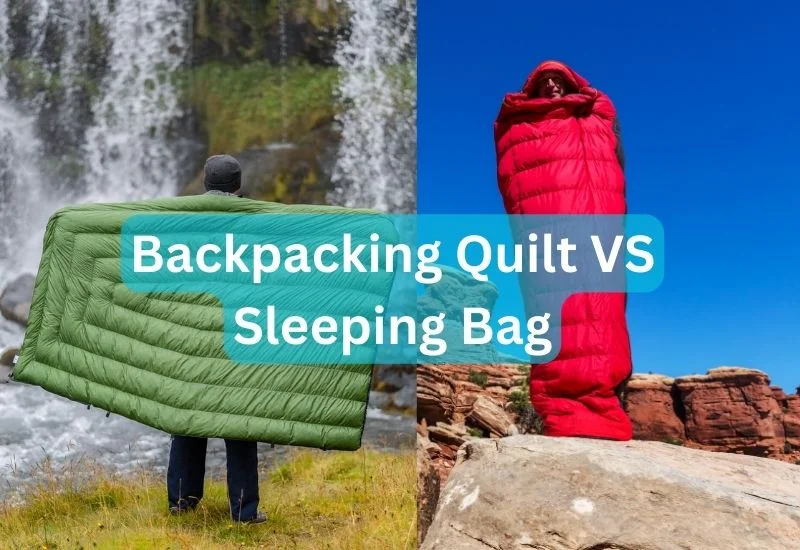
Edited by Abdullah Faraz on July 26, 2024
When going for western mountaineering, hiking, or backpacking, you always need a backpacking quilt or a sleeping bag. But people are always confused between these two sleep systems. As both are used for the same purpose, but are different in their specifications.
Which one will be more suitable for you depends upon your needs and personal preferences. But without knowing the comparative features of both these items, you can’t select the most suitable for you.
So in the following blog post, you will find a comprehensive difference between the backpacking quilt vs sleeping bag, with respect to backpacking. It will give you a clear idea about not only the functionalities of these items but also their pros and cons.
So here we go!
Factors To Consider

Warmth
The main function of both the quilt and the sleeping bag is to provide warmth. But which one fulfills that function properly? Which one is better at providing the heat or retention of heat? The answer lies in the construction of these items.
The sleeping bag is a portable bedding for outdoor sleeping. Its shape is just like an insulated covering. This covering is opened and closed with a zipper from one side of the head. This insulation provides not only thermal insulation but also insulation for water and light. After closing the zippers, it forms a tube-like shape that is closed completely from every side.
The backpacking quilt is actually a half-sleeping bag. It is not closed from the bottom. It covers three sides and remains open from one side. Unlike sleeping bags, there is no hood, zipper, or bottom layer. As this design allows heat to escape and does not make it a completely insulated tube, you will need another insulated layer for the base layer.
Yes, the sleeping bed provides greater insulation and greater warmth than the quilt in cold nights. However, this is a very minimal difference in warmth if properly set up.
Weight
When you compare the weight of an equivalent quilt and a sleeping bed, you will see a great difference in their weight. As the quilts don’t come with a hood, zipper, or bottom side, they weigh far less than the sleeping bed. You can say that the lesser weight of the quilt equates to the lesser warmth of the quilt than the sleeping bed.
Packability
When it comes to packing, the quilt needs far less space than the sleeping bed. Not only this, but it is also quite easier to pack the quilt than the sleeping bed. Moreover, it requires less time to re-loft the quilt than the sleeping bag.
Warmth To Weight
When you take a quilt and a sleeping bed of the same size, the quilt will be 20 to 30 % lighter than the sleeping bed. But at the same time, there is a minor difference in the temperature of both these items. Sleeping bags being covered from every side will insulate more heat than the quilt. However, in the ratio of warmth to weight, the quilts will be the clear winner.
Temperature Regulation
When you see the temperature regulation factor, both have their pros and cons. On the coldest nights, you will need a full insulated bag with zippers. Full zipped bags regulate the temperature very well. These bags are fully insulated and will not allow the heat and warmth to transmit and ultimately raise the temperature.
On the other hand, on warm balmy nights, you want to have a quilt with one side opening. It will help you to maintain a medium temperature. Even in cold nights, you can maintain a higher temperature in quilts with a down blanket or a sleeping pad attachment.
Ease Of Setup
Sleeping bags are always ready to use. You just unpack the sleeping bag and get into it. And then close the zip easily. So, if you want to sleep easy after a long day of hiking, a sleeping bag will be the best option for you. You will find it a little difficult to get in and out of the sleeping bag when you are in a hurry.
However, setting up the quilt is a little time-consuming process. You have to attach the rear closures with the sleeping pad according to the desired temperature and comfort.
Sleeping Comfort
There are several factors in both sleeping items. In case of cold nights, you will definitely need a sleeping capsule. That will provide warmth all night long. However, due to the resemblance of sleeping bags with mummy bags, they will cover the body like a capsule.
But at the same time, if you want to sleep in any position you want, then backpacking quilts will be the better option. You can easily move and change the sides according to your comfort in the quilt due to its attachment system. There is an attachment system in the quilt.1 This system keeps it on hold and avoids any tangling and twisting in the quilt. So you can roll and wriggle around in the quilt.
SUMMARY
Sleeping bags offer superior warmth with full insulation, ideal for colder nights, while quilts are lighter and more compact, making them perfect for those who value packability.
Both have their pros and cons in temperature regulation, weight, and ease of setup, so consider your needs for warmth, comfort, and convenience when making your decision.
Comparison table of Sleeping bag and Backpacking Quilt
| Features | Sleeping bag | Backpacking Quilt |
| Warmth | Greater warmth | Lower warmth |
| Weight | More weight | Less weight |
| Packability | More space | Less space |
| Temperature regulation | High temperature | Low temperature |
| Ease Of Setup | Easy to set up | Take a little effort to set up |
| Sleeping comfort | Less comfortable | More comfortable |
Which One Is Better For You?

The answer to this question is quite subjective. Everyone will have their own analysis and will select the one that satisfies their peace of mind. The one who is habitual of sleeping in one position will definitely find the sleeping bed a better option. In the very same way, the one who wants an easy setup will prefer the sleeping bag.
However, a person who continuously changes positions while sleeping will definitely need a quilt. Furthermore, the one who likes a continuous airflow will prefer the quilt. Likewise, there are many other advantages such as their versatility, their lesser cost, taking up less space, and weighing less etc.
Sleeping With A Backpacking Quilt
Backpacking quilts don’t come with a bottom pad. You have to complement it with an extra sleeping pad. This will provide insulation between you and the ground under you.
- First of all, select a quilt suitable for the temperature of the place where you are going. You can check the temperature ratings and comfort ratings from the manufacturer’s website.
- Now use the pad straps to wrap around the sleeping pad and then toggles the bag with the straps. This will keep the points of drafts close against the pads.
- Enter into the quilt by sliding your feet up to the foot box.
- Adjust the quilt according to your ease using the straps and wrap the sides of the quilt under your body. You can use the extra strings to keep the quilt at its place the whole night.
Quilts don’t have head hoods. Therefore, if you want to keep your head warm, use hats or caps that insulate your head. Quilts are best for those people who prefer loose and lighter gear.
Sleeping With a Sleeping Bag
You can zip and unzip the sleeping bag both from the outside and inside of the bag. Moreover, you can tighten the opening through a string under your head. You can follow this step-by-step guide for having a comfortable sleep in the Sleeping bag.
- Find a flat and dry surface to lay your bag flat to its full length. You can use a padded mat under your sleeping bag.
- Now open the zipper halfway and then slip yourself into the bag.
- Adjust yourself in the bag until you feel comfortable and your legs can touch the other end of the bag.
- You can now zip your bag completely to keep the warmth inside the bag. You can use the string or hood under your head to tighten the bag and keep your head warm.
You should keep essentials nearby, such as a flashlight, water bottle, insect repellent, or other items near your sleeping bag. Moreover, avoid wearing sweaters or warm clothes in the sleeping bag, these will cause sweating.2
Packing Method

Packing Sleeping Bag
- Air Your Bag Before Packing.
Backpackers recommend airing your sleeping bag by shaking it after using it every time. Even if it is too cold outside, it will cause sweating in the sleeping bag, as they are highly insulated and warm. This can cause an unpleasant smell. Moreover, you should keep these bags in a dry and airy place.
- Rolling Or Folding
Rolling is a habitual way to pack the bag into the sack. But the fibers of the bag will bend and get collected at the same place. Moreover, there are chances that the zippers will be damaged.
You will need a lot of time to fold. Moreover, a folded sleeping bag will occupy more space as you cannot compress it too much.
- Stuffing In The Storage Sack
Simply hold the foot end of the bag and start pushing it into the storage sack. But make sure to remove all the air from the bag. Keep pushing the bag as down as possible until you have stuffed the complete sleeping bag into the sack. The storage sack will keep the insulation evenly distributed throughout the bag.
Make sure to put these bags out of these storing sacks immediately after you have reached your destination. Keep your bags in storage bags where they can be stuffed lightly.
Packing Backpacking Quilt
You can use the same steps to pack the quilt in the dry sacks or compression sacks. Simply stuff your quilt in the bottom of the sack. You can do so by holding one end of the quilt and forcing it down into the sack.
Conclusion
Both the sleeping bag and quilt are used to protect you from the cold. And both these items perform their function very well. However, quilts are becoming popular due to their lightweight and versatility.
One thing is clear in mind: sleeping beds provide far better protection from coldness and draught. So, in colder areas, sleeping bags are a far better option. But you have to compromise on the weight of the sleeping bag.
Frequently Asked Questions
Article Sources
Bagsbucks provides reliable information with good-quality references to support the facts.
